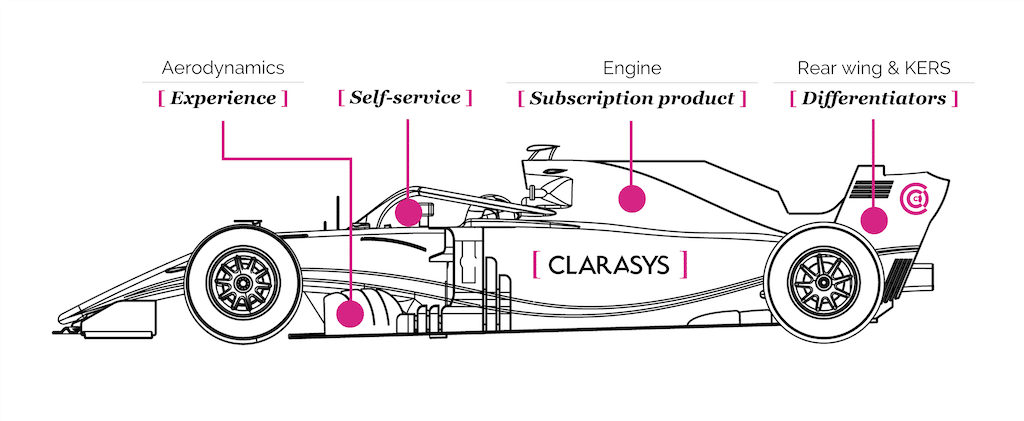In this blog, we explore how building an F1 car relates to subscription product development and key considerations for success.
How to define and launch a subscription product

How to define and launch a subscription product
In this blog, we explore how building an F1 car relates to subscription product development and key considerations for success.

Meet the author
Welcome to our Drive to Subscribe blog series, created to provide readers with insight into the world of subscriptions while drawing parallels with the world of Formula 1. In this, part two, we will look at key considerations for successful subscription product development. You can find part one here which explores the approach to a successful subscription.
Creating a subscription product and packages that are competitive is ultimately the key to success. But there’s more to it. Each element of the subscription has to be set up for success; the support model also has to work well and the customer needs clarity on what’s expected of them.
In F1 it’s the same; the car has been put through its paces, the supporting tech has been tested, and the driver is clear about what is expected of them.
Outlined below are some of the key items to consider when producing a subscription product in the same way you need to think about the components of a car.
Key subscription product development considerations
The product itself
In F1, the engine is the star of the show, the driving force behind the car that gets you moving. Without it nothing else matters and you achieve nothing. Likewise, the product at the heart of a subscription is the engine. It is the core of the offering and what the customer is fundamentally interested in. If the product doesn’t meet the customer’s needs, the driving force of the subscription is lost. Focus efforts on understanding your customers and their needs and make sure that your product caters to them effectively.
Brand and aesthetic
The chassis is what sponsors and spectators first see when watching F1, not the engine. Even though the engine is the star, the way a car is ‘dressed up’ to attract attention by standing out on track and social media is hugely important. The importance of product branding and marketing is the same for a subscription. Developing a robust go-to-market strategy is crucial to targeting the right customers and generating interest, but also needs to have the flexibility to extend, pivot and attract a wider customer base as needed over time. Understand your customer personas and mature them, working to tailor not only the product but how you position and sell it to them, working alongside and building upon your existing brand.
Performance and experience
One of the key variables and differentiating factors in F1 is the aerodynamics of the car and how it feels to drive. The aerodynamics dictate how effectively the car punches through the air, do you maximise downforce for grip and cornering or minimise it to help top speed? It’s not always possible to have both and you have to compromise and find the right balance.
In developing your subscription product you have to make similar key decisions around your product strategy, what the product will do and the customer experience you will offer. To be better than your competitors in all aspects is often the ambition but rarely achievable. Achieving subscription success will require intentional decisions on where to excel and outperform your competition and where you can accept being weaker based on your competitive proposition.
Are simplicity, speed and ease of use core to your subscription product or will you target being more sophisticated? Sophistication often leads to greater complexity and in turn potential challenges for customers adopting and using the product, but ultimately provides the customer with a richer experience and set of features once they’re onboarded.
Race strategy
On race weekend the teams and drivers have to work out what strategy they think gives them the best chance of winning, this involves setting the car up with different parts, choosing what type of tyres they will use and when they intend to make pit stops to change them etc. Getting these decisions right will give the driver the best chance of winning and getting them wrong could prove costly to their performance.
Subscription product pricing and packages are much the same in that you have to work with your customer to work out the best package and price plan to meet their needs, maximising satisfaction for the customer and long-term revenue (through loyalty) for you. A critical trade-off that any company has when selling subscriptions is balancing customer experience and flexibility of the offering with the internal investment and or overheads to service that offering.
Increasingly customers want hyper-personalisation in all their interactions and purchases. Giving customers huge amounts of flexibility in how they purchase a subscription, at what price point and on what terms offers a seemingly great bespoke and tailored experience. However, it can also drive a lot of technology complexity and back office overheads to manage and fulfil orders. This can either erode margin and profitability of the subscription or inflate the price for customers which in turn reduces the perceived value and experience associated with the subscription product itself due to the higher price point. Alternatively having tightly defined and fewer subscription options may appear to limit flexibility but it also improves consistency. This consistency will enable greater efficiency in fulfilment and service which improves the customer experience and keeps internal costs, and therefore price for customers down too.
Differentiators and self-service
One of the critical differentiators on race day is how effectively drivers use things like DRS (Drag Reduction System), KERS (Kinetic Energy Recovery System) and steering wheel settings to supplement and improve their car’s performance. This is a kind of self-service for the driver that helps them to improve overall performance.
Today some degree of self-service is non-negotiable for customers. It is critical for both the customer experience and the efficiency of your internal operations that customers are able to self-serve and make adjustments to certain elements of their subscription digitally. This allows them to tailor certain aspects of their experience to better suit their needs, giving them greater control and reducing internal overheads associated with subscription support. This should be supplemented by additional support, discounts and insights on how customers might benefit from offers, new features or improve their usage of their subscription.
Testing, data and continuous improvement
In F1, testing, data analysis, and continuous improvement are integral components that play a crucial role in enhancing performance, reliability, and competitiveness. Whether that is full end-to-end testing, like in preseason, midseason or simulator, or specific reporting from telemetry data, performance analytics and driver feedback. All these help to inform adaptive strategies and continuous component upgrades to enhance overall performance.
Testing, data analysis and continuous improvement are equally important to successful subscriptions. During development, testing helps validate the product and remove bugs to optimise performance and customer experience. Gathering customer feedback, monitoring usage data and identifying trends can also be used to help define ongoing development and iterative improvements to the subscription as well as informing retention strategies and maximising customer retention.
Subscription development is all about balance and like F1 there is no golden rule or ratio that teams can look to. Success is dependent on a lot of trial and error, setting up the right monitoring and feedback mechanisms to understand your customers and product performance to better meet their needs and continuously adapt and evolve with the market. Later in the series, we will discuss how best to manage the balance and costs associated with your ongoing subscription product development, operations and technology infrastructure.
In the next blog, we’ll look at optimising operating models to support subscriptions.
If you need help revving up subscription success for your business, please get in touch.
To subscribe to this series, please complete this form:

